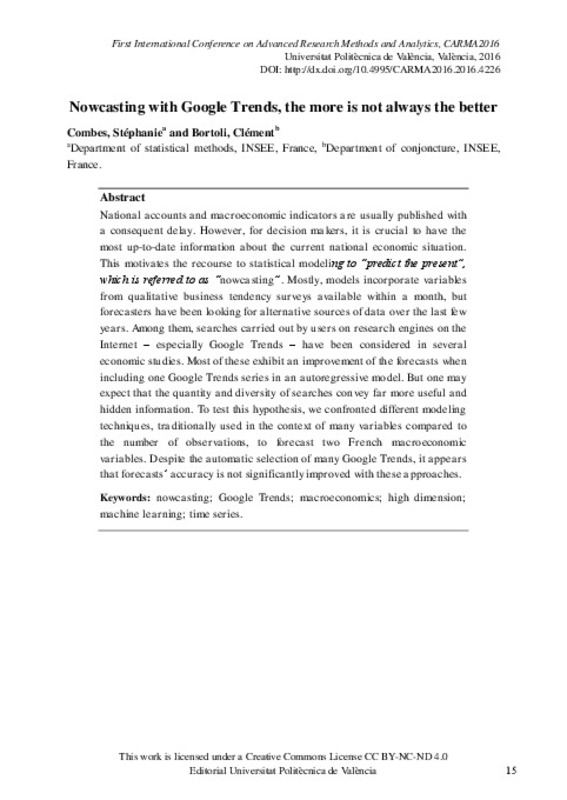JavaScript is disabled for your browser. Some features of this site may not work without it.
Buscar en RiuNet
Listar
Mi cuenta
Estadísticas
Ayuda RiuNet
Admin. UPV
Nowcasting with Google Trends, the more is not always the better
Mostrar el registro sencillo del ítem
Ficheros en el ítem
| dc.contributor.author | Combes, Stéphanie
|
es_ES |
| dc.contributor.author | Bortoli, Clément
|
es_ES |
| dc.date.accessioned | 2017-07-10T07:10:52Z | |
| dc.date.available | 2017-07-10T07:10:52Z | |
| dc.date.issued | 2016-10-10 | |
| dc.identifier.isbn | 9788490484623 | |
| dc.identifier.uri | http://hdl.handle.net/10251/84789 | |
| dc.description.abstract | [EN] National accounts and macroeconomic indicators are usually published with a consequent delay. However, for decision makers, it is crucial to have the most up-to-date information about the current national economic situation. This motivates the recourse to statistical modeling to “predict the present”, which is referred to as “nowcasting”. Mostly, models incorporate variables from qualitative business tendency surveys available within a month, but forecasters have been looking for alternative sources of data over the last few years. Among them, searches carried out by users on research engines on the Internet – especially Google Trends – have been considered in several economic studies. Most of these exhibit an improvement of the forecasts when including one Google Trends series in an autoregressive model. But one may expect that the quantity and diversity of searches convey far more useful and hidden information. To test this hypothesis, we confronted different modeling techniques, traditionally used in the context of many variables compared to the number of observations, to forecast two French macroeconomic variables. Despite the automatic selection of many Google Trends, it appears that forecasts’ accuracy is not significantly improved with these approaches. | es_ES |
| dc.language | Inglés | es_ES |
| dc.publisher | Editorial Universitat Politècnica de València | es_ES |
| dc.relation.ispartof | CARMA 2016: 1st International Conference on Advanced Research Methods in Analytics | es_ES |
| dc.rights | Reconocimiento - No comercial - Sin obra derivada (by-nc-nd) | es_ES |
| dc.subject | web data | es_ES |
| dc.subject | internet data | es_ES |
| dc.subject | big data | es_ES |
| dc.subject | qca | es_ES |
| dc.subject | pls | es_ES |
| dc.subject | sem | es_ES |
| dc.subject | conference | es_ES |
| dc.title | Nowcasting with Google Trends, the more is not always the better | es_ES |
| dc.type | Capítulo de libro | es_ES |
| dc.type | Comunicación en congreso | es_ES |
| dc.identifier.doi | 10.4995/CARMA2016.2015.4226 | |
| dc.rights.accessRights | Abierto | es_ES |
| dc.description.bibliographicCitation | Combes, S.; Bortoli, C. (2016). Nowcasting with Google Trends, the more is not always the better. En CARMA 2016: 1st International Conference on Advanced Research Methods in Analytics. Editorial Universitat Politècnica de València. 15-22. https://doi.org/10.4995/CARMA2016.2015.4226 | es_ES |
| dc.description.accrualMethod | OCS | es_ES |
| dc.relation.conferencename | CARMA 2016 - 1st International Conference on Advanced Research Methods and Analytics | es_ES |
| dc.relation.conferencedate | July 06-07,2016 | es_ES |
| dc.relation.conferenceplace | Valencia, Spain | es_ES |
| dc.relation.publisherversion | http://ocs.editorial.upv.es/index.php/CARMA/CARMA2016/paper/view/4226 | es_ES |
| dc.description.upvformatpinicio | 15 | es_ES |
| dc.description.upvformatpfin | 22 | es_ES |
| dc.type.version | info:eu-repo/semantics/publishedVersion | es_ES |
| dc.relation.pasarela | OCS\4226 | es_ES |








